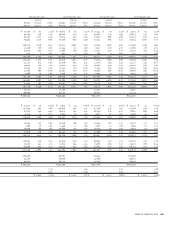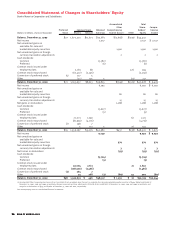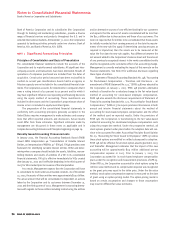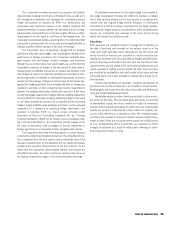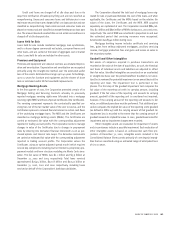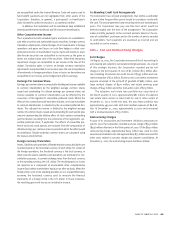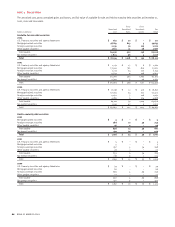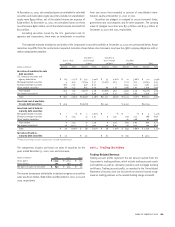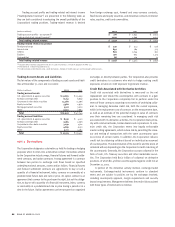Bank of America 2002 Annual Report Download - page 78
Download and view the complete annual report
Please find page 78 of the 2002 Bank of America annual report below. You can navigate through the pages in the report by either clicking on the pages listed below, or by using the keyword search tool below to find specific information within the annual report.
76 BANK OF AMERICA 200276 BANK OF AMERICA 200276 BANK OF AMERICA 2002
Bank of America Corporation and its subsidiaries (the Corporation)
through its banking and nonbanking subsidiaries, provide a diverse
range of financial services and products throughout the U.S. and in
selected international markets. At December 31, 2002, the Corporation
operated its banking activities primarily under two charters: Bank of
America, N.A. and Bank of America, N.A. (USA).
NOTE 1 Significant Accounting Principles
Principles of Consolidation and Basis of Presentation
The consolidated financial statements include the accounts of the
Corporation and its majority-owned subsidiaries. All significant inter-
company accounts and transactions have been eliminated. Results of
operations of companies purchased are included from the dates of
acquisition. Certain prior period amounts have been reclassified to
conform to current year classifications. Assets held in an agency or
fiduciary capacity are not included in the consolidated financial state-
ments. The Corporation accounts for investments in companies that it
owns a voting interest of 20 percent to 50 percent and for which it
may have significant influence over operating and financing decisions
using the equity method of accounting. These investments are
included in other assets and the Corporation’s proportionate share of
income or loss is included in equity investment gains.
The preparation of the consolidated financial statements in
conformity with accounting principles generally accepted in the
United States requires management to make estimates and assump-
tions that affect reported amounts and disclosures. Actual results
could differ from those estimates. Significant estimates made by
management are discussed in these notes as applicable and in
Complex Accounting Estimates and Principles beginning on page 29.
Recently Issued Accounting Pronouncements
In January 2003, the Financial Accounting Standards Board (FASB)
issued FASB Interpretation 46 “Consolidation of Variable Interest
Entities, an interpretation of ARB No. 51” (FIN 46). FIN 46 provides a new
framework for identifying variable interest entities (VIEs) and deter-
mining when a company should include the assets, liabilities, noncon-
trolling interests and results of activities of a VIE in its consolidated
financial statements. FIN 46 is effective immediately for VIEs created
after January 31, 2003 and is effective beginning in the third quarter of
2003 for VIEs created prior to issuance of the interpretation.
As a result, Management expects that the Corporation will have
to consolidate its multi-seller asset backed conduits. As of December
31, 2002, the assets of these entities were approximately $25.0 billion.
The actual amount that will be consolidated is dependent on actions
taken by the Corporation and its customers between December 31,
2002 and the third quarter of 2003. Management is assessing alterna-
tives with regards to these entities including restructuring the entities
and/or alternative sources of cost-efficient funding for our customers
and expects that the amount of assets consolidated will be less than
the $25.0 billion due to these actions and those of our customers. The
new rule requires that for entities to be consolidated that those assets
be initially recorded at their carrying amounts at the date the require-
ments of the new rule first apply. If determining carrying amounts as
required is impractical, then the assets are to be measured at fair
value the first date the new rule applies. Any difference between the
net amount added to the Corporation’s balance sheet and the amount
of any previously recognized interest in the newly consolidated entity
shall be recognized as the cumulative effect of an accounting change.
Management is currently evaluating the impact of this new rule on the
financial statements. See Note 8 for additional disclosure regarding
these types of entities.
Statement of Financial Accounting Standards No. 148, “Accounting
for Stock-Based Compensation – Transition and Disclosure – an
amendment of FASB Statement No. 123,” (SFAS 148) was adopted by
the Corporation on January 1, 2003. SFAS 148 provides alternative
methods of transition for a voluntary change to the fair value-based
method of accounting for stock-based employee compensation.
SFAS 148 also amends the disclosure requirements of Statement of
Financial Accounting Standards No. 123, “Accounting for Stock-Based
Compensation,” (SFAS 123) to require prominent disclosures in both
annual and interim financial statements about the method of
accounting for stock-based employee compensation and the effect
of the method used on reported results. Under the provisions of
SFAS 148, the Corporation is transitioning to the fair value-based
method of accounting for stock-based employee compensation costs
using the prospective method. Under the prospective method, all
stock options granted under plans before the adoption date will con-
tinue to be accounted for under Accounting Principles Board Opinion
No. 25, “Accounting for Stock Issued to Employees,” (APB 25) unless
these stock options are modified or settled subsequent to adoption.
SFAS 148 will be effective for all stock option awards granted in 2003
and thereafter. Management estimates that the impact of this new
accounting will be approximately $115 million additional pre-tax
compensation expense in 2003. Prior to January 1, 2003, the
Corporation accounted for its stock-based employee compensation
plans under the recognition and measurement provisions of APB 25.
Under APB 25, the Corporation accounted for stock options using the
intrinsic value method and no compensation expense was recognized
as the grant price was equal to the strike price. Under the fair value
method, stock option compensation expense is measured on the date
of grant using an option-pricing model. The option-pricing model is
based on certain assumptions and changes to those assumptions
may result in different fair value estimates.
Notes to Consolidated Financial Statements
Bank of America Corporation and Subsidiaries





